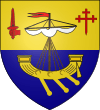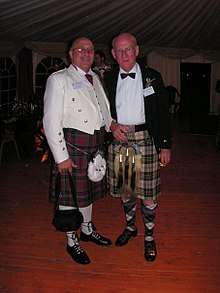Clan Macpherson
Clan Macpherson (/məkˈfɜːrsən/, ![]()
| Clan Macpherson | |||
|---|---|---|---|
| Clann Mac a' Phearsain | |||
 | |||
| Motto | "Touch not the cat but a glove." - current "Touche not le chat bot a glove." - archaic | ||
| Profile | |||
| Region | Highlands | ||
| District | Badenoch | ||
| Plant badge | White Heather | ||
| Chief | |||
 | |||
| Sir William Macpherson | |||
| Chief of Clan Macpherson | |||
| Seat | Newton Castle | ||
| Historic seat | Cluny Castle | ||
| |||
| |||
| |||
History
Origins
.jpg)

The Scottish Gaelic surname for Macpherson is Mac a' Phearsain which means son of the parson.[3] The Celtic church allowed priests to marry and the progenitor of the chiefs of Clan Macpherson is believed to have been a man named Muireach or Murdo Cattenach who was the priest of Kingussie in Badenoch.[2] The Clan Macpherson is part of the Chattan Confederation (Clan Chattan).[2] In 843 the chief of Clan Chattan was Gille Chattan Mor and one of his sons, the first chief of Clan Macpherson was forced to resettle in Lochaber by Kenneth MacAlpin, first king of Scots.[2] The chief could have been the lay prior of Ardchattan and he seems to have been named in honour of Saint Cathan.[2] Touch not the cat bot a glove. 'Bot' means without. The 'glove' of a wildcat is the pad. If the cat is 'ungloved', its claws are unsheathed. The motto serves as a warning that one should beware when the wildcat's claws are 'without a glove'. It is a reference to the historically violent nature of the clan and serves as a metaphorical warning to other clans that they should think twice before interfering with Macpherson business.
Macpherson clan traditions is that in 1309 Robert the Bruce offered the lands of Badenoch to the chief of Clan Macpherson if they destroyed the Bruce's enemies, the Clan Comyn, and the Macphersons carried out the king's wishes.[2] The Clan Macpherson is sometimes known as the Clan of the Three Brothers owing to the fact that chief Ewan Ban Macpherson had three sons: Kenneth Macpherson of Clunie, Iain Macpherson of Pitman and Gillies Macpherson of Invereshie.[2]
14th-century clan conflicts
In 1370 the Battle of Invernahavon took place between the Chattan Confederation and the Clan Cameron. There was a dispute between the Macphersons and another clan of the confederation, the Clan Davidson over who should take the right wing in the battle.[2] The Clan Mackintosh, whose chiefs were also chiefs of the Chattan Confederation favoured the Davidsons and as a result the Macphersons left the field of battle.[2] The Clan Cameron took advantage of this situation and gained the upper hand, however the Macphersons were eventually coerced back into the battle and the Camerons were defeated.[2] The feud between the Clan Cameron and Chattan Confederation continued for many years after and in 1396 the Battle of the North Inch took place, which was watched by Robert III of Scotland and his whole court.[2]
17th century and civil war
In 1618 Andrew Macpherson, eighth chief of Clan Macpherson acquired the abbey-castle grange in Strathisla.[2] Andrew's son, Euan Macpherson supported the royalist cause during the Scottish Civil War and fought for James Graham, 1st Marquess of Montrose.[2] The tenth chief was Duncan Macpherson of Cluny who in 1672 lost his claim to lead the Chattan Confederation.[2] The Privy Council of Scotland instead found in favour of a Mackintosh.[2] Duncan had no sons and in 1722 was therefore succeeded as chief of Clan Macpherson by Lachlan Macpherson, fourth Laird of Nuid.[2]
18th century Jacobite uprisings
Clan Macpherson having supported the Jacobite rising of 1715, General Wade's report on the Highlands in 1724, estimated the clan strength at 220 men.[4] Chief Euan Macpherson of Cluny was a notable leader in the Jacobite rising of 1745 and fought at the Clifton Moor Skirmish.[2] 300 Macphersons took part in the Atholl raids of March 1746.[5] After the Jacobite defeat at the Battle of Culloden, Cluny was able to escape capture by government troops for nine years even though a reward of £1000 was offered for his capture.[2] He escaped to France in 1755.[2] William Macpherson, who was killed at the Battle of Falkirk (1746), is the ancestor of the current Chief of Clan Macpherson.[2] His brother witnessed government "red coats" burning Macpherson of Cluny's house.[2] Duncan Mapherson of Cluny fought in the British Army during the American Revolutionary War.[2]
Castles
- Cluny Castle, about five miles south-west of Newtonmore in Strathspey was a stronghold of the clan.[6] The original castle dated from the fourteenth century but was razed by the Duke of Cumberland after the Jacobite rising of 1745 which the Macphersons had supported.[6] The present Cluny Castle is in fact a nineteenth century mansion that was built on the site of the original stronghold.[6]
- Ballindalloch Castle was built by the Clan Grant and owned by the Ballindallochs before coming to the Macphersons, now the Macpherson-Grants.[6]
- Newton Castle, Blairgowrie, Perthshire is the current seat of the Macpherson chiefs.[6]
- Invereshie House, near Kingussie, Strathspey was held by the Macphersons from the fourteenth century.[6] William Macpherson of Invereshie captured Blair Castle from the Marquess of Montrose in 1644.[6]
- Pitmain House, near Kingussie, Strathspey was held by the Macphersons from the fourteenth century.[6] The present building forms part of the Highland Folk Museum.[6]
See also
- Macpherson, list of people with the surname
- Scottish clan
References
- Scots Kith & Kin. HarperCollins. 2014. p. 78. ISBN 9780007551798.
- Way, George and Squire, Romily. (1994). Collins Scottish Clan & Family Encyclopedia. (Foreword by The Rt Hon. The Earl of Elgin KT, Convenor, The Standing Council of Scottish Chiefs). pp. 256 - 257.
- Mac an Tàilleir, Iain. "Ainmean Pearsanta" (docx). Sabhal Mòr Ostaig. Retrieved 15 October 2009.
- Johnston, Thomas Brumby; Robertson, James Alexander; Dickson, William Kirk (1899). "General Wade's Report". Historical Geography of the Clans of Scotland. Edinburgh and London: W. & A.K. Johnston. p. 26. Retrieved February 19, 2020.
- Duffy, Christopher (2003). The '45, Bonnie Prince Charlie and the Untold Story of the Jacobite Rising. Cassell. pp. 470–477.
- Coventry, Martin. (2008). Castles of the Clans: The Strongholds and Seats of 750 Scottish Families and Clans. pp. 398 - 399. ISBN 978-1-899874-36-1.